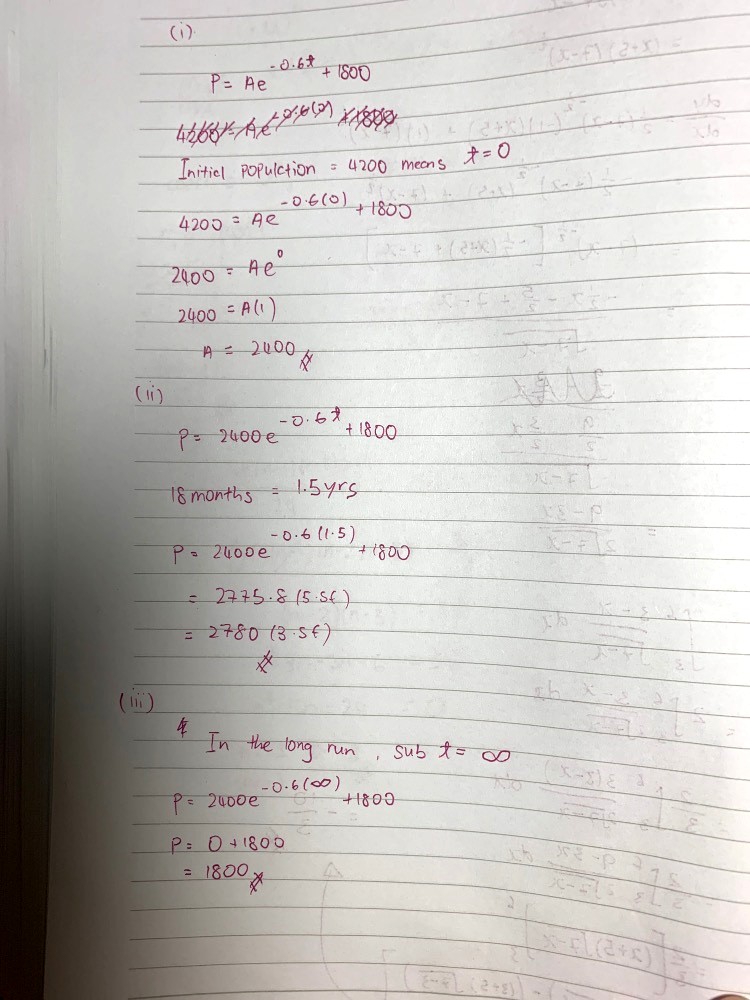Ask Singapore Homework?
Upload a photo of a Singapore homework and someone will email you the solution for free.

See 1 Answer
done
{{ upvoteCount }} Upvotes
clear
{{ downvoteCount * -1 }} Downvotes

For part (a) the initial population is 4200 this means the time is 0 so just sub both values into the equation u will be able to find A constant
For part (c), because of the e in the equation, e graph will never reach 0. So usually sub t=infinity because u don’t know how long is in the long run. So to be safe just sub t=infinity. Anything power infinity will = 0. Hope this will help
For part (c), because of the e in the equation, e graph will never reach 0. So usually sub t=infinity because u don’t know how long is in the long run. So to be safe just sub t=infinity. Anything power infinity will = 0. Hope this will help
Date Posted:
3 years ago
It is not true that 'anything to the power of infinity = 0' . Try it without the negative sign on the exponent.
Besides, infinity is not a fixed/tangible value so you cannot simply substitute it in like how you would substitute something like t = 5.
Presenting like this will result in loss of marks since it is mathematically incorrect.
Besides, infinity is not a fixed/tangible value so you cannot simply substitute it in like how you would substitute something like t = 5.
Presenting like this will result in loss of marks since it is mathematically incorrect.
Cate, for your info :
As t increases, e^(-0.6t) decreases, since :
e^(-0.6t) = 1/e^(0.6t)
e^(0.6t) > 0 for all positive t. It increases exponentially as t increases.
Since the denominator increases, 1/e^(0.6t) will decrease as you are dividing by a more positive value than before.
So in the long run, t tends to infinity.
When t tends to infinity, so will e^(0.6t)
This means 1/e^(0.6t) tends to 0 (but never reaches 0) since it is getting smaller and smaller.
Since P = 2400e^(-0.6t) + 1800,
if e^(-0.6t) tends to 0, 2400e^(-0.6t) will tend to 0 as well since it is a multiple of it.
Then 2400e^(-0.6t) + 1800 tends to 1800.
So the population approaches 1800 in the long run.
Working :
P = 2400e^(-0.6t) + 1800
As t → ∞, e^(0.6t) → ∞
1/e^(0.6t) → 0
e^(-0.6t) → 0
2400e^(-0.6t) → 0
2400e^(-0.6t) + 1800 → 1800
So P → 1800
As t increases, e^(-0.6t) decreases, since :
e^(-0.6t) = 1/e^(0.6t)
e^(0.6t) > 0 for all positive t. It increases exponentially as t increases.
Since the denominator increases, 1/e^(0.6t) will decrease as you are dividing by a more positive value than before.
So in the long run, t tends to infinity.
When t tends to infinity, so will e^(0.6t)
This means 1/e^(0.6t) tends to 0 (but never reaches 0) since it is getting smaller and smaller.
Since P = 2400e^(-0.6t) + 1800,
if e^(-0.6t) tends to 0, 2400e^(-0.6t) will tend to 0 as well since it is a multiple of it.
Then 2400e^(-0.6t) + 1800 tends to 1800.
So the population approaches 1800 in the long run.
Working :
P = 2400e^(-0.6t) + 1800
As t → ∞, e^(0.6t) → ∞
1/e^(0.6t) → 0
e^(-0.6t) → 0
2400e^(-0.6t) → 0
2400e^(-0.6t) + 1800 → 1800
So P → 1800





